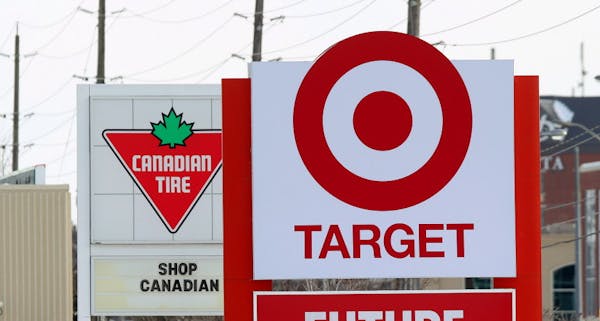Giving Canadians what they expected was never going to be easy for Target Corp. when the giant retailer moved into the country last year.
That fact was underscored in a week of hand-wringing that saw the Minneapolis-based retailer fire the Canadian president who oversaw a billion-dollar loss in operations north of the border. In the aftermath, analysts said the market is simply too small, too spread out and too distinct from the United States — problems that have bedeviled many U.S. retailers who tried to expand north.
"I don't think Target misunderstood what Canadian customers wanted," said Robert David, a business professor at McGill University in Montreal. "They just couldn't deliver it."
Target vows it can turn things around. After reporting a 16 percent drop in quarterly profit on Wednesday, including continued losses in Canada, interim CEO John Mulligan talked of a new approach to that market.
The company named 15-year Target veteran Mark Schindele as its new boss in Canada, where the company opened 124 stores in just 12 months. It also plans to appoint a nonexecutive chairman for the country to devise strategies that will resonate with Canadian shoppers.
"We recognize that we've disappointed Canadian guests," Mulligan said Wednesday. "We think we're a great retailer. We have not lived up to our potential, nor our expectations."
Canada has become a critical new market for U.S. companies seeking customers to stimulate growth and sustain recovery from the Great Recession. But Canadian disappointment is not limited to Target.
While Wal-Mart has established a Canadian niche and Costco has more stores per capita in the country than in the United States, companies such as Richfield-based Best Buy, Big Lots and Sears have struggled, either cutting operations or withdrawing entirely.
Although each of these companies have had problems unique to their brands and products, experts say a lack of planning and understanding of the Canadian market often explains the lack of success.
Target's Canadian troubles began with size. The country has only a tenth the population of the United States.
This makes it difficult to offer the range of selection available in the United States. Meanwhile, higher labor and real estate costs in Canada drive prices higher. The combination soured many Canadians who were used to crossing the border to shop at Target stores.
"From cross-border shopping in the past, Canadian consumers — especially those in urban areas — are quite familiar with price/variety levels in U.S. stores," said Minha Hwang, another McGill retail expert. "Because of these high expectations, Canadian consumers find Canadian stores of U.S. retail chains less attractive."
The stock on the shelves was not as varied as what many Canadians expected, and it cost more than what many Canadians were used to paying south of the border, said Sean Naughton, who studies Target for Piper Jaffray & Co.
A recent poll commissioned by Toronto's Globe and Mail newspaper found only 18 percent of customers "very satisfied" with the stores Target launched in Canada more than a year ago. The satisfaction rate was down from 27 percent in August 2013, the newspaper said, and down from 32 percent when Target began its Canadian expansion.
Dan Valerio of the Ernst & Young Global Limited business consultancy warned that U.S. retailers must avoid approaching Canada "with the mind-set that everything is same except population size."
For instance, Target's attempt to open more than 100 stores in its first year in Canada assured "very real operational difficulties," McGill's David said. "Supply chains are just very different here."
Naughton said it would have been much better to start with a smaller set of stores to understand the market and how consumers were going to shop.
"It is all about going at a measured pace," Naughton said.
But it is not just about shopping habits. The smaller Canadian market is spread over a land mass larger than the United States. Canada has far fewer metropolitan areas, separated in some cases by thousands of miles. The upshot, said Hwang, is that Canadian stores cannot be serviced with "an American distribution network."
Companies have tried various approaches to the challenges that Canada presents.
Costco flourished by offering guaranteed low prices for brand name items in exchange for membership fees, Naughton said.
Best Buy purchased the Canadian electronics chain Future Shop when it tried to move into the Canadian market in the 2000s. "They bought Canadian expertise," David said. But the purchase of brick-and-mortar stores did nothing to thwart the company's loss of customers to online shopping sites.
In Target's case, the company got squeezed between Wal-Mart and a Canadian grocery chain called Loblaws. Wal-Mart branded itself by being first on the scene and occupying better sites for its stores than the locations Target purchased en masse from Zellers, a Canadian department store chain, David said.
At the same time, Loblaws had added apparel and goods to its inventory and established a clothing brand called Joe Fresh that has loyal customers.
None of this bodes well for Target. At this point, analysts say, all of the issues that cost Target Canada President Tony Fisher his job continue to face his replacement.
The company says it plans to improve the shopping experience and work on keeping shelves better stocked. A spokeswoman talked last week about "an opportunity to reintroduce ourselves to the Canadian market."
Target Canada's missteps have been painful for shareholders. Naughton said things will need to change, or the retailer may eventually have to exit the market.
Jim Spencer • 202-383-6123
